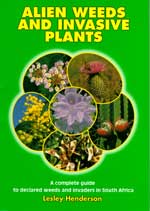 |
Alien weeds and invasive plants: a complete guide to declared weeds and invaders in South AfricaBy Lesley Henderson
Published in 2001 by the Plant Protection Research Institute, Agricultural Research Council, 300 pages, colour and b&w, soft cover
Price $A88.00 plus $A12 postage within Australia [up to 3 kg], overseas postage please request a quote
ISBN 1868491927 or ISBN 9781868491926 |
- Description
- Table of contents
- Review
Descriptions, distributions and beautiful line drawings of 234 species, colour photographs of 100 species. Includes a quick guide to identification of the major groups of plants: grasses/reeds, aquatics, herbs, climbers, succulent trees/shrubs, woody trees/shrubs. Information about poisonous and irritant species.
Lists other sources of information, and includes a comprehensive glossary as well as a botanical and common names index.
Table of contents
Foreword
Introduction
Acknowledgements
Guide to the identification of the species (pages 8-227)
Photographs of selected species (colour section)
Invasive status
Declared weeds and invaders in South Africa
Other sources of information
Glossary
Index of botanical and common names
Map of South Africa and places
Quick guide (inside back cover)
Review
Lesley Henderson, from the Plant Protection Research Institute, has described in this publication all 198 declared species of weeds in South Africa plus a further 36 species which have been identified as potentially invasive. All but about 20 species are native or naturalised in Australia.
The plants described in this book are all alien species introduced into southern Africa, either intentionally or unintentionally. Some species are confined to places of severe human disturbance and are classified as ruderal weeds (of waste places) and agrestal weeds (of cultivated lands). By far the majority of species in this book are invaders of natural and semi-natural habitats and they are classified as environmental weeds or invaders. The most aggressive invaders are capable of penetrating and replacing indigenous vegetation. They threaten both agricultural productivity and natural ecosystems in South Africa.
This book is sub-divided into five major sections:
• Grasses and Reeds (10 species),
• Aquatics (10 species),
• Terrestrial Herbs (38 species)
• Climbers (25 species), and
• Trees and Shrubs (155 species).
Sub-categories within sections provide further assistance in identification. A quick guide to the identification of invaders has been placed inside the back cover for easy reference and will assist the reader in locating a species within the book based on characteristics that are always visible.
Each species description includes the scientific name (and synonym where applicable), English and Afrikaans common names, family, short diagnostic description with important features underlined, cultivated use, habitats invaded, region of origin and invasive status. Species that are known to be poisonous or irritant are noted. Excellent line drawings of each species are provided with each description, and a collection of coloured photographs is provided towards the rear of the book. Species distribution maps are also included with each species. The legal status of declared species is indicated in the text as well as by a symbol for quick reference.
This book is a very useful weed identification guide with clear drawings and simple plant descriptions. Given that almost all of plants described occur in Australia, either as weeds or useful species, it is a useful addition to ones collection of weed identification books. It is also a fascinating snapshot of the alien flora of South Africa and the methods and legislation used to deal with these problem weeds. And it can alert us to plants that have the potential to become problems in Australia given the similarity in climate between the two countries.